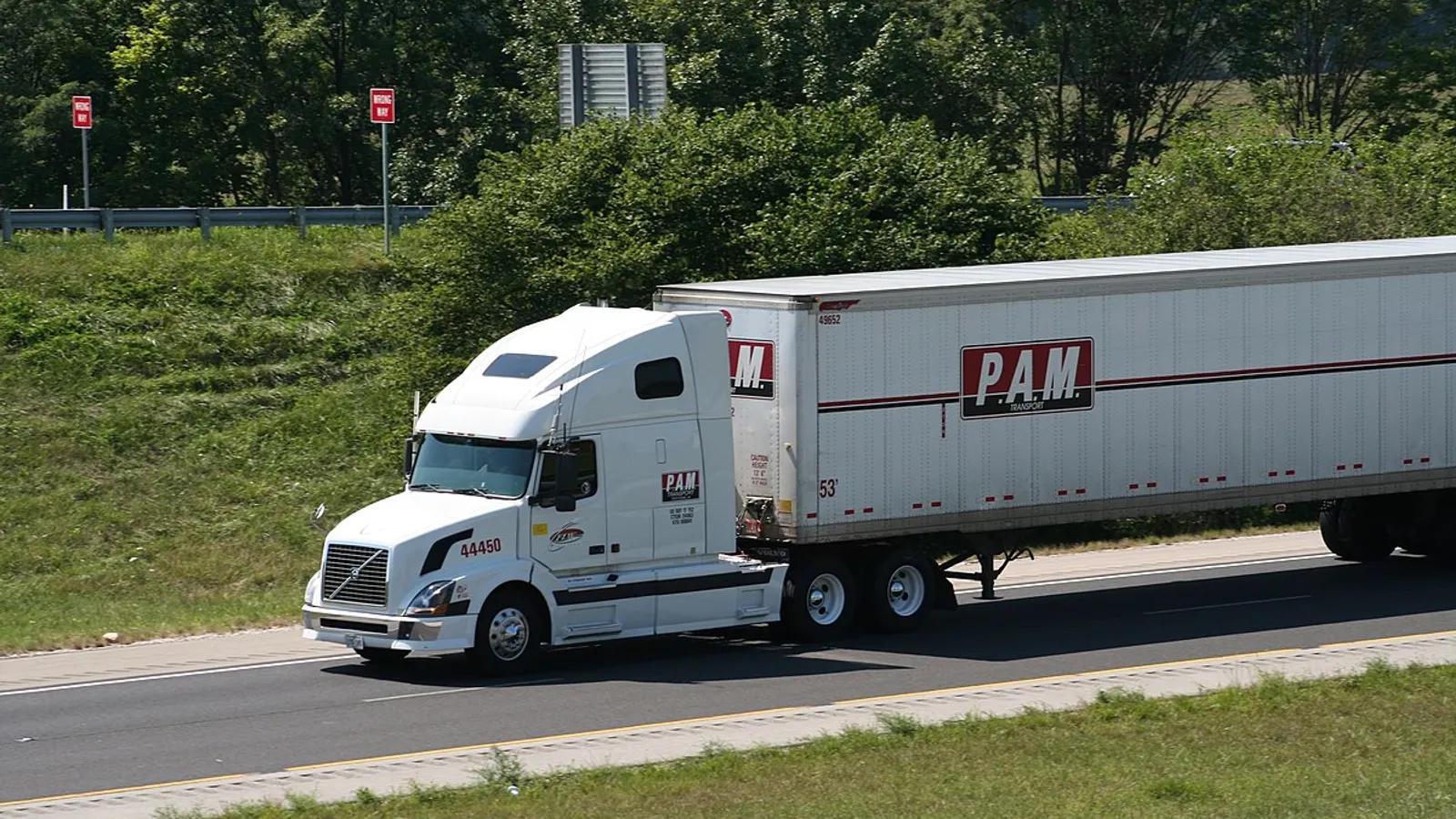P.A.M. Transport trafił na pierwsze strony gazet dzięki swoim ostatnim wynikom finansowym, szczególnie po trudnym drugim kwartale, w którym firma ugięła się pod ciężarem strat operacyjnych. Sytuacja ta rzuca światło na zmienny krajobraz logistyki i transportu, kluczowy aspekt globalnego handlu.
Analiza Wyników Finansowych
W oświadczeniu o zyskach spółka macierzysta P.A.M. Transport ogłosiła stratę operacyjną w wysokości $11,1 miliona za drugi kwartał, z stratą netto w wysokości $9,6 miliona. Ten spadek koniunktury oznacza trzeci z rzędu kwartał, w którym odnotowano straty, po wcześniejszych ciosach ujemne $37,7 miliona w czwartym kwartale 2025 roku i ujemne 1,2 miliona PLN w pierwszym kwartale 2025 roku.
- Kwestie operacyjne: Wskaźnik operacyjny transportu ciężarowego osiągnął 112.5% w drugim kwartale, wskazując na nieefektywność.
- Spadek wolumenu: Liczba łącznych mil i ładunków spadła, natomiast średnia liczba ciężarówek należących do właścicieli-operatorów wzrosła w porównaniu z rokiem poprzednim.
Analiza wpływu
Problemy finansowe, z którymi boryka się P.A.M. Transport, malują wyraźny obraz ich wyzwań operacyjnych. Ostatni kwartał reprezentuje niepokojący trend w roku naznaczonym trudnościami. Decyzja o skorygowaniu wartości sprzętu związanych z amortyzacją w czwartym kwartale mogła złagodzić cios, ponieważ uwidoczniła bardziej korzystną skorygowaną stratę operacyjną w wysokości $6,6 miliona, ale niewiele pomaga to w ukryciu trwających trudności.
Niestabilność przywództwa dodatkowo komplikuje sytuację. W zeszłym miesiącu dyrektor generalny P.A.M. Transport ustąpił ze stanowiska, co skłoniło prezesa firmy, Matthew Morouna, do objęcia funkcji zarówno tymczasowego prezesa, jak i dyrektora generalnego. Firma żegluje przez burzę, gdzie zmiany operacyjne mogą być konieczne, aby przetrwać te finansowe zawirowania.
Logistyka na kurczącym się rynku
Sektor logistyczny odczuwa presję, ponieważ wielu przewoźników zgłasza spadki przychodów z transportów całopojazdowych w całej branży. Na przykład Knight Swift Transportation Holdings odnotował poprawę swojego wskaźnika operacyjnego do 96.3% w drugim kwartale, podczas gdy Heartland Express poniósł stratę operacyjną. $12,4 miliona. Ponadto TFI International napotkało trudności, a wskaźnik operacyjny transportu ciężarowego pogorszył się do 90.1%.
- Niepewność związana z taryfami: Jednym z podstawowych problemów w branży jest trwająca niepewność taryfowa, która hamuje popyt na rynku. Przewoźnicy czekają, podczas gdy klienci wahają się, stając się coraz bardziej ostrożni w swoich ustaleniach logistycznych.
- Obserwacje rynkowe: W miarę jak P.A.M. Transport dąży do odbudowy, wnikliwe analizy wskaźników operacyjnych ujawniają niepokojące trendy w branży, które mogą kształtować przyszłość logistyki.
Implikacje dla przyszłości logistyki
Wyzwania, przed którymi stoi P.A.M. Transport, mogą być zwiastunem dla całego sektora logistycznego. Utrzymujące się straty operacyjne wskazują na problem strukturalny, który może odbić się szerokim echem w całym ekosystemie logistycznym. W miarę jak firmy radzą sobie z obecnymi warunkami ekonomicznymi, kluczowe staje się ponowne przeanalizowanie strategii operacyjnych i efektywności.
Doświadczenie P.A.M. Transport podkreśla znaczenie podejścia opartego na danych w operacjach. Posiadanie wiedzy i zrozumienia trendów rynkowych umożliwi firmom podejmowanie świadomych decyzji, pozwalając im na zmianę kierunku działania w trudnych czasach.
Uczenie Się na Przeciwnościach Losu
Jak mówi przysłowie, „Nie ma tego złego, co by na dobre nie wyszło”. Dla P.A.M. Transport te trudności finansowe mogą posłużyć jako katalizator wzrostu i zmian. Stanowią one okazję do analizy słabości, usprawnienia operacji i wprowadzania innowacji w celu zwiększenia wydajności w obliczu przeciwności losu.
Wnioski
Rzeczywistość jest taka, że sektor logistyczny pozostaje skomplikowaną siecią współzależności, a wyniki poszczególnych firm mogą mieć wpływ na cały krajobraz. Straty operacyjne P.A.M. Transport podkreślają słabe punkty w segmencie transportu całopojazdowego, stwarzając istotne implikacje dla szerszego rynku logistycznego. Pomimo licznych wyzwań, platformy takie jak GetTransport.com podejmują działania, aby oferować przystępne cenowo globalne rozwiązania transportu towarów, zarówno dla przeprowadzek domowych, relokacji biur, jak i dostaw towarów wielkogabarytowych. Usługi świadczone przez GetTransport.com stanowią przykład niezawodności i wygody, szczególnie w okresach zmian na rynku.
Ostatnie wyzwania finansowe, przed którymi stanęła firma P.A.M. Transport, otwierają dialog na temat poruszania się po logistyce w niepewnych czasach. W dzisiejszym szybko zmieniającym się środowisku, gdzie efektywność operacyjna może zadecydować o sukcesie lub upadku firmy, posiadanie niezawodnych partnerów może zapewnić sprawniejsze procesy frachtu i transportu. Wybierając GetTransport.com do transportu ładunków, firmy mogą lepiej zarządzać wydatkami, zapewniając jednocześnie skuteczne zaspokojenie swoich potrzeb w zakresie dostaw. Zaangażowanie platformy w przejrzystość umożliwia użytkownikom podejmowanie świadomych decyzji logistycznych bez ponoszenia zbędnych kosztów i komplikacji. Zarezerwuj już teraz na GetTransport.com.

 P.A.M. Transport wciąż zmaga się z problemami finansowymi w obliczu przeciwności losu">
P.A.M. Transport wciąż zmaga się z problemami finansowymi w obliczu przeciwności losu">